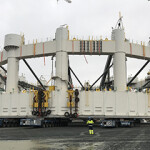Palau tackles IUU fishing with innovative technologies and partnerships
Palau, a Pacific island nation of just 21,000 people, is on the front lines of the fight against illegal, unreported and unregulated (IUU) fishing, but the small country has only one patrol boat – with two more on the way – to cover hundreds of thousands of square miles of ocean. So the country has turned to innovative partnerships, including working with groups that track illegal fishing using satellite-based ship location data.
Caleb Otto is Palau’s ambassador the United Nations, which last year passed a treaty to end illegal, unreported and unregulated (IUU) fishing. SeafoodSource recently interviewed Otto about Palau’s efforts to combat IUU fishing and the country’s decision in establishing a marine sanctuary twice the size of Mexico in 2015 that forbids nearly all fishing.
SeafoodSource: How important is the UN treaty forbidding IUU fishing? Is the UN moving fast enough on this issue?
Otto: The treaty is very important because, if implemented well, it will ensure that illegal fishing vessel find no ports of refuge. The main challenge is that the catch still has to be certified and this is where the small island states face great difficulties due to constrained resources including lack of capacity. There remains the fact that only 29 countries have ratified the agreement. The good news, however, is that the European Union, the United States, and Japan are among the 29. Success is very much dependent on the giant seafood markets in the world – the EU, Japan and United States – to harmonize their institutional transparency, accountability, and sustainability activities.
SeafoodSource: How big a portion of the Palau economy does fishing account for? How many people in Palau rely on fishing for their food and for income?
Otto: Fish and other seafood items continue to be the main sources of food for Palauans. However, the commercial value of fishing has always accounted for a very small proportion of the Palau economy. During the debates for establishment of the Palau National Marine Sanctuary, it was often argued that various factors in the commercial fishing arrangements put only about 17 cents of every dollar into Palauan hands. Overall, Palau leaders agreed that the benefits from commercial fishing were worth less than the benefits Palau could reap from a nationally concerted effort to secure a healthy ocean through the Palau National Marine Sanctuary.
SeafoodSource: What kind of fishermen live in Palau? Are these small-scale fishermen, catching just enough for their families? Are they selling fish into international markets? Have their families been fishing these waters for generations?
Otto: Local Palauan fishermen who have learned the skills from their fathers have fished in the Palau waters since time immemorial. They are good fishermen. They love and respect the ocean. Fishing methods they use include spearing, free-dive fishing with spear-guns, net-fishing with commercially made nets or with coconut fronds, and various line-fishing ranging from bottom fishing to casting or trawling. Most fishermen fish basically to meet family needs but may sell extra catch at local markets, including at local hotels and restaurants.
SeafoodSource: Palau has a small population, but an enormous amount of territorial ocean. What resources is the Palau government devoting to enforcing rules on illegal fishing?
Otto: The most important resource that Palau has in its fight against illegal fishing is the love and respect of its people for the ocean and the desire to protect it. Palau relies on and actively seeks assistance from its friends and allies to help with enforcing the rules governing activities on its enormous amount of territorial ocean. Currently, the most important resources available are through assistance from Australia, United States, and Japan. The MV Remeliik is currently the only patrol boat patrolling the Palau waters. It was built by the government of Australia.
SeafoodSource: What are the challenges in enforcing fishing rules over such a large expanse of ocean? How do you overcome those challenges?
Otto: The challenges in monitoring such a vast territorial ocean, about 1.5 million square miles, continue to be about lack of resources, financing, and capacity. Technological advances offer distance monitoring and surveillance via satellite and drones. Such resources have to be paid for and local capacity has to be available to achieve maximum benefits from available technology. In its efforts to address the challenges, Palau actively seeks to secure the required resources through public and private partnerships.
SeafoodSource: What other technologies and innovative enforcement methods is Palau using to combat illegal fishing?
Otto: Palau has been looking into the possibility of deploying drones for combating illegal fishing. The use of national sanctuaries is an innovative method for combating IUU…The more sanctuaries are established, the easier it would be to combat IUU. Burning of poacher boats, while neither cutting-edge technology nor an innovative enforcement method, has been used recently by Palau to combat illegal fishing. Our president did not think that just stripping the rogue boats of their nets and confiscating their catches was enough.
SeafoodSource: Why is reducing illegal fishing especially important to Palau's economy?
Otto: President Tommy E. Remengesau is fond of describing tourism as “our bread and butter.” And, indeed, it is the main engine of economic development of Palau. Just within the past decade, it has grown from 65,000 to 125,000 visitors per year … Reducing illegal fishing is important to Palau’s economy because abundant and healthy fish stocks would strengthen tourism in at least three ways. They ensure adequate supply of fish to feed locals and visitors. They provide healthier and sustainable use of fish such as sport fishing. And they provide opportunity for locals and visitors to view and appreciate the abundance and variety of fishes.






Share